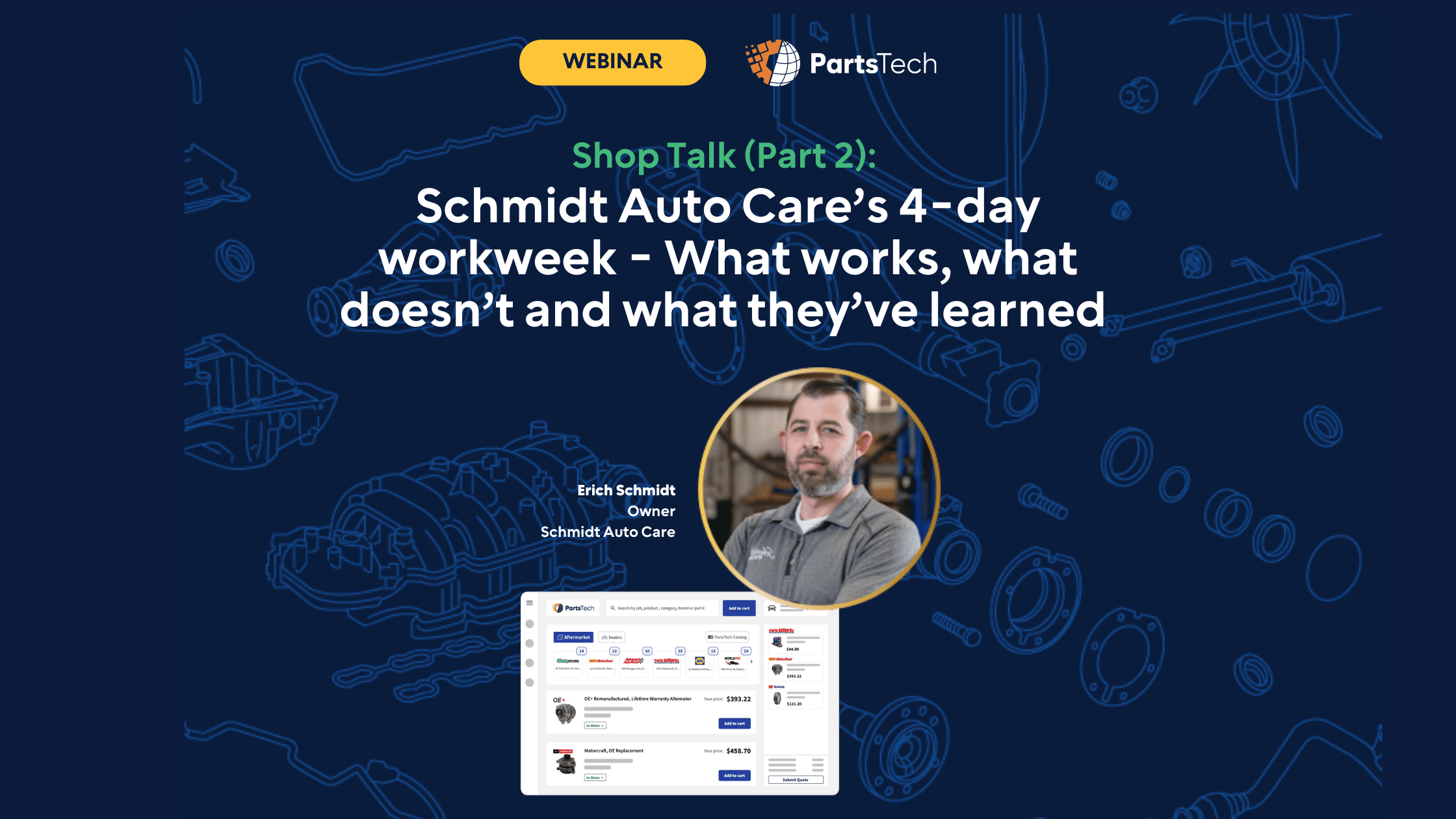
At PartsTech, a big part of our mission is to save auto shops time when procuring parts. Because of that, we are often interested in learning what our customers do with the time they gain back and how PartsTech helps them innovate around their shops. One trend we’ve noticed gaining traction with some shops is the shift to a four-day work week. It’s understandable to be skeptical when first hearing “four-day work week” and wonder if a shop can really get everything done in just four days without sacrificing productivity. That’s why we wanted to learn how this model works in practice, the challenges shops face in making the shift, and the real benefits it can offer.
Recently, we sat down with CEO and founder of Schmidt Auto Care, Erich Schmidt, to discuss how he went from skeptic to believer in the four-day work week, and everything he and his team learned along the way.
About Schmidt Auto Care
Founded in 2009 by Master ASE technician Erich Schmidt, Schmidt Auto Care has grown from a two-bay service station into a leading 14-bay, 12,000-square-foot facility in Springboro, Ohio. Built on values of trust, honesty, and community, the shop has become a well-established name in people-focused car care.
Catch Erich Schmidt’s insights on how he made the four-day work week a success. Watch the recorded webinar now!
Watch Now HERE
What Is the Four-Day Work Week?
First, it’s important to define exactly what a four-day work week is. There are a few models, but the most common one we’re hearing from users is the compressed work week. This means the shop is still open for 40 hours a week, but instead of five eight-hour days, it’s four ten-hour days. Erich implemented the compressed work week model at Schmidt Auto Care, operating his shop Monday through Thursday, 8 am to 7 pm. He says his employees usually arrive around 7:45 am, and they kick off their morning with a five-minute team meeting before getting started for the day.
Erich also made a point to mention that there are no late nights in his shop. Everybody leaves at 7 pm and, on very rare occasions, he stays late. But overall, everyone is able to get everything they need to get done within their working hours.
What Is the Impact on Employees and Shop Productivity?
Numerous studies have found that the compressed four-day work week can help improve performance ratings and job satisfaction without any changes in absenteeism or productivity. Specifically, a 2024 study of 247 construction company workers found that switching to a compressed workweek improved work-life harmony without increasing fatigue. It’s important to note that those benefits were closely tied to employers clearly communicating expectations and guiding their employees through the change.
For Erich, his employees were the ones who gave him the idea to experiment with a four-day week. He was resistant at first, as he was concerned that work would pile up, leading to a stressful end-of-week catch-up crunch. However, a strategic use of time didn’t just help his shop avoid that chaos, it enhanced productivity.
Working ten-hour days, by noon, his techs have their approvals and parts and are able to have their heads-down and focused on work until the shop closes. This heads-down time was also leveraged by Erich’s front of the house by allowing them to carry out more customer retention tasks and callbacks until the five o’clock rush for quality checks and pick-ups.
After making the change, Erich saw major improvements in employee well-being and performance. His employees come into work refreshed now, which leads to fewer mistakes and higher quality work. Retention improved after reducing the work week, and when it comes to attracting new talent, a three-day weekend is a big draw.
What Is the Impact on Clients?
Despite the potential benefits for employees and operations, there can still be some hesitations around the four-day work week and how it may impact client experience. While all shops are different, AutoLeap, a shop management software provider, reports that most auto repair shops see their busiest hours on weekdays between 8 am and 6 pm. This is because people typically drop off their cars before work or pick them up after work. So, adding those extra hours can actually help get more customers in and out in a single day, especially for those customers who work late. Like with employees, communication will be key, not just in shifting customer expectations, but in enhancing the overall customer experience.
Erich stresses the need for upfront communication with clients if a shop decides to adopt the work model. His shop does this right upfront when clients make their appointment, especially if they’re coming in on a Thursday. It’s no different than communicating costs upfront, and it helps establish trust.
Ultimately, the four-day work week enabled Erich’s shop to be sharper when it comes to customer experience. His clients found longer hours of operation to be more accommodating than a traditional eight-hour workday. Additionally, after implementing the change, he noticed that his employees were more engaged and enthusiastic with customers, which he credits to improved job satisfaction. Overall, one thing Erich promises from his years of experience is that if you provide a superior service that customers enjoy, they will come back to you every time.
If you provide a superior service that customers enjoy, they will come back to you every time.
Erich schmidt
How Can I Successfully Make the Shift?
To successfully shift to a four-day work week, you’ll want to make sure your shop is already operating efficiently with streamlined processes in place. You already know that the quicker you get information from your service writer to your technician, the quicker your shop can turn a repair and start on the next vehicle. If you see a lag there, consider new ways to enhance your current processes and procedures. Remember, enhancing efficiency in the front of your house improves efficiency in the back of your house.
For Erich, going digital was key when setting his shop up to transition to a four-day week. Leveraging technology like PartsTech helped Erich’s team cut back on time wasted on calls to different suppliers for parts, and more time focusing on shop operations, whether that was customer retention or physically working on cars in their bays.
Once you feel confident from an operational standpoint that you can make the shift, you will need to discuss the transition with your whole team and make sure everyone is on board. It’s important that everyone feels involved in the decision and understands the expectations of a shortened work week.
Switching to the four-day work week is about more than simply cutting operation hours. It’s about being efficient and people-focused. With the right tools and united team, it’s possible to not just get by on a four-day work week, but thrive. Because this work model is not about doing less, it’s about doing better, together.
Want additional insight into how PartsTech streamlines the parts ordering process? Let’s connect you with a PartsTech pro! Complete the form below and we will be in touch!
New to PartsTech and want to learn about how it can help you streamline your operations? Create your free account today!
Create a Free PartsTech Account Here!



